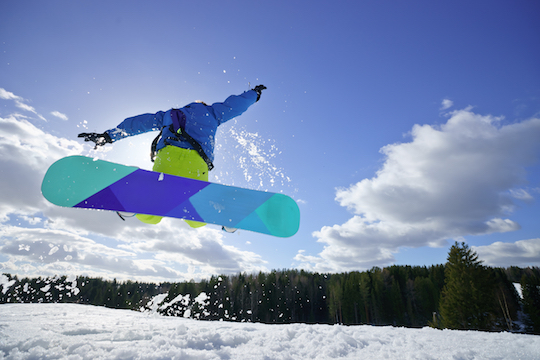Snowboard Injuries and Prevention

Introduced in the United States in 1965 when Sherman Poppen bolted two skis together, snowboarding became popular with the introduction of commercial snowboards in the late 1970s. The popularity of snowboarding was further boosted after its introduction as an Olympic sport at the 1998 Winter Games in Nagano, Japan. In the 1980s, most snowboarders were young males. Recent surveys have shown that females and older persons are increasingly more apt to take up this sport. For example, the male-to-female participant ratio dropped from 9 to 1 in 1989 to 3 to 1 in 1995 (American Family Physician.)
Snowboarding is an extreme winter sport and as with any sport, there is a chance of injury, ranging from minor falls to high impact crashes. Although advanced snowboarders may try more dangerous maneuvers such as jumps and other aerial tricks, beginning snowboarders are the most frequently injured. This is often because they haven’t yet learned how to maintain a stable stance on the board and are thus more likely to catch an edge and fall. In fact, nearly 25% of injuries occur during a snowboarder’s first experience and almost half occur during their first season of boarding.
Considering the fact that both your feet are affixed in non-release bindings to a relatively narrow snowboard, it would seem logical that falling is the leading cause of injury. Jumps are the second most common cause of injuries and may be associated with head, facial, spinal, and abdominal injuries. Jumps are followed by collisions, often with stationary objects and/or other snowboarders or skiers. The overall injury rate is estimated to be 4 per 1,000 snowboarding days, similar to that in alpine skiing.
Compared to skiing, snowboarding injuries usually involve the upper extremities and the ankle. When snowboarders lose their balance, they can’t release their binding in order to recover, as both feet are firmly attached to the board. The instinctive protective reaction of a snowboarder then is to outstretch a hand to break the landing, thus placing the upper limb at risk of injury. Nevertheless, serious injuries are rare in snowboarding and generally occur when you lose control and collide with an inanimate object, like a tree. Wrist injuries are by far the most common of all snowboarding injuries, followed by ankle, and knee injuries.
Wrist Injuries
Wrist injuries tend to occur when snowboarders catch an edge, lose their balance, fall, and instinctively react by outstretching a hand in order to try and break that fall. Falling backwards and landing on your hands is a common occurrence, especially for those who are just learning how to ride. Hard impacts of those falls may cause sprains or possibly fractures to the smaller wrist bones.
If you fall back, try not to catch your fall with your hands because by doing so, you will be placing all the impact on your wrists. It is safer to teach yourself to fall on your elbows, especially if you are wearing elbow pads. As you fall backwards, keep your hands in front of you and point your elbows backwards as your elbows are able to absorb a much harder impact than your wrists. Even better is to roll out of a fall as this will distribute the impact over a greater portion of the body. Aside from teaching yourself proper falling techniques, wearing wrist guards are the best method of injury prevention. If you have wrist guards that you wore for inline skating or skateboarding, these will offer the same type of protection. Otherwise, most winter sports stores sell a variety of different styles and brands. Choose the style that offers you the greatest protection and comfort.
Ankle Injuries
Currently, fewer than one third of snowboarding injuries are to the lower extremities. The lead leg, which is at greatest risk, accounts for almost three quarters of such injuries. Ankle injuries occur mostly from hard sideway impacts such as crashes and are particularly common after jumping when a combination of compression and inversion (the ankle turning in) mechanisms are experienced. This may lead to an ankle sprain or to a more serious condition called “snowboarder’s ankle” – a fracture of the lateral process of the talus.
As with skiing, snowboard gear has a significant effect on the type and frequency of certain injuries. Generally, the risk of sustaining an ankle injury as a snowboarder is related to the kind of boots worn:
Hard Shell Boots tend to be worn by more experienced boarders and (as with ski boots) tend to protect the ankle joint. Hard shell boots lend themselves to a “boot top fracture” – a fracture of both the tibia and fibula. Although riders who opt for stiffer lace-up boots or alpine/carving boots are less likely to have ankle injuries, they may be more prone to knee injuries.
Soft boots are favoured by beginners because they allow some degree of ankle movement, which helps the rider to maneuver the board more easily. Unfortunately, soft boots give the snowboarder about twice the risk of ankle injury compared with hard boots. Any forces transmitted back from the board tend to be absorbed by this joint. This normally happens when the ankle is either compressed or inverted, which can occur after a jump.
If you’re a beginner, keep your bindings set relatively loose to spare your knees during falls. As you improve, you can gradually tighten the bindings to improve your control over the board.
Knee Injuries
During snowboarding, the knees are the natural springs of that absorb most of the shocks. Interestingly, 4 to 8 percent of snowboarding injuries take place while the person is waiting in ski-lift lines or entering and exiting ski lifts. Snowboarders push themselves forward with a free foot while in the ski-lift line, leaving the other foot (usually that of the lead leg) locked on the board at a 45- to 90-degree angle, placing a large torque force on this leg and predisposing the person to knee injury if a fall occurs. However, compared to skiing, knee injuries are less common and less severe in snowboarding for several reasons.
First, a snowboard only has two edges that can “catch” unexpectedly on snow as opposed to the four edges on skis. Also, snowboards tend to be shorter than skis; hence the lever arm of force produced by any twist is reduced. Most knee injuries in snowboarding are caused by extremely hard collisions (such as when you hit a tree), or impacts from unexpected angles or turning motions. To avoid such injuries, make sure you know your limitations; the time it generally takes for you to make a turn and your ability to make a sharp turn if need be. Keep in mind that as your snowboarding technique improves, your ability to absorb harder impacts will also intensify. Also, while boarding, make sure you keep your knees bent at all times, especially when performing jumps or tricks.
Head Injuries
Crashes with natural objects, such as hard snow surfaces or ice, rocks and trees, or unnatural objects such as rails and boxes on a half pipe, can cause concussions and serious head injuries. As a result, helmets are an essential component of any snowboarder’s gear. Although there’s little doubt about the importance of wearing a helmet, keep in mind that wearing one while snowboarding does not make you invincible. It is not unlike a football injury where concussions still occur even while wearing a helmet, and these injuries can have deleterious effects, years after. If you are going to go down the hill at mach speed, and you collide into a tree, you will most likely suffer injuries as a result.
Snowboard helmets are meant to reduce the risk and severity of such injuries and are certainly expected to be of benefit in more minor impacts, glancing blows and other similar mishaps. When buying a helmet, make sure to purchase one designed for snowboarding as they are specifically designed to combat injuries sustained in the sport.
Whether you’re a novice or an expert, prevention is the name of the game. Please take the necessary precautions and wear the proper gear when hitting the slopes.
Enjoy and be safe,
Dr. Crysta Serné
Chiropractor and owner of Vitality Clinic
- Posted: December 5, 2017
- | by: Dr. Crysta Serne
- | Categories: Wellness Articles
- | Tags: Head Injuries, Injury Prevention, Snowboarding, Sports, Wrist







Leave a Reply